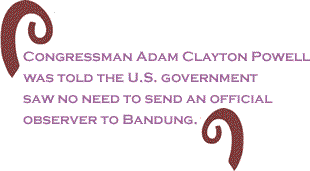
|
|||||||||||||||||||||
|
History will record two Bandung conferences. The one recently concluded, marking the golden jubilee of the first, and the one held in April 1955 at which 29 African and Asian nations met in Bandung, Indonesia to promote economic and cultural cooperation and to oppose colonialism. The idea of the Bandung Conference came from Ahmed Sukarno of Indonesia. It was conceived in Colombo, Indonesia, where the Colombo powers – India, Pakistan, Ceylon (now Sri Lanka), Burma (now Myanmar) and Indonesia, the host country – met in April 1954. The Bandung Conference led to the 1961 creation of the Non-Aligned Movement. The first head of state to arrive at the 2005 conference was South African President Thabo Mbeki. Ironically, South Africa along with Israel, Taiwan and North and South Korea were all barred from the 1955 conference. In light of recent tragic events, Mbeki visited the tsunami stricken province of Aceh before he proceeded to the conference. I first heard about the Bandung Conference in the mid-1960s while listening to a speech by El-Hajj Malik Shabazz (Malcolm X) titled "Message to the Grassroots,” which was first delivered at the King Solomon Baptist Church in Detroit on November 10, 1963. Malcolm talked about places and faces I had never heard of, however, he didn't get it completely correct. There were White people at the Bandung conference. Marshal Tito represented Yugoslavia, and there were American, Australian and numerous members of the European press at the conference. In fact, African American journalist Ethel Payne, who was at Bandung, pointed out, “The British had sent just hordes of correspondents, and the Dutch and the Germans and all the Europeans countries."
Africans in North America paid close attention to this historic event. In Canada, Daniel Braithwaite's organization, which had a relationship with the U.S.-based Council on African Affairs (CAA), sent a message of support. Braithwaite was so impressed by CAA co-founder Paul Robeson that he not only started a CAA chapter in Toronto, he named his son Paul in tribute to Robeson. Other Africanists like W.E.B. DuBois, Alphaeus and Dorothy Hunton, along with Robeson, were members of the Council on African Affairs. At the time of the first Bandung Conference, the North American left, in general, and the African American liberation movement in particular were under attack. Senator Joseph McCarthy was looking for a "red under every bed.” Robeson, "the Tallest Tree in the Forest," wanted to attend the conference but couldn't because the U.S. government had taken his passport. Ditto for DuBois. However, several African American politicians and journalists found themselves in Indonesia from April 18-25, 1955. Adam Clayton Powell Jr., Carl T. Rowan, Dr. Marguerite Cartwright, journalist Payne and Richard Wright all were there. Powell, the Congressman from Harlem, went to the Conference on a dare. He wanted to attend the event to represent the interest of U.S. imperialism by talking about the progress the Negro in America was making. "It will mark the first time in history that the world's non-White people have held such a gathering," he told reporters in Washington, D.C., "and it could be the most important of this century." Powell, no matter what we think of him, knew what time it was. His appeals to President Dwight D. Eisenhower and others in the State Department fell on deaf ears. The flamboyant Powell was told the U.S. government saw no need to send an official observer to Bandung. However, he got there compliments of the African American weekly newspaper, New York Age-Defender.
Karl Evanzz pointed out in his brilliant book, The Judas Factor, "There was at least one unofficial observer: at the request of John Foster Dulles' brother, CIA Director Allen Dulles, a young African American journalist named Carl T. Rowan covered the conference." Rowan went on to become the Director of the United States Information Agency. He also went on to alienate a generation of African Americans after the February 21, 1965 assassination of Malcolm X. Rowan's statement after Malcolm's death was: "All this about an ex-convict, ex-dope peddler who became a racial fanatic." Of the two female African American journalists at the conference, the well-connected Dr. Cartwright represented a chain of White dailies and the United Nations. The lesser-known Payne was the new kid on the block and represented the Chicago Defender, which was part of John Sengstacke's chain of Black weeklies.
Payne, who went on to be crowned "The First Lady of the Black Press", said she had little or no contact in Indonesia with Dr. Cartwright. Of Cartwright, Payne said, "She had a desk at the U.N. and so she had quite a lot of access that I didn't have." However, Payne did network with writer Richard Wright, a one-time member of the Communist Party U.S.A. who went on his own and wrote the book, Color Curtain, about The Bandung Conference. Color Curtain was first published by University Press of Mississippi in 1956. Wright wrote about the faces and places in Indonesia in 1955, and one can feel him learning about what would come to be called "The Third World.” The first Bandung Conference was attended by 21 Asian, seven African and one Eastern European country. The second was attended by 54 Asian and 52 African nations. The Asian-African Conference has been transformed into the Asia-Africa Summit. A recent re-reading of Robeson's Here I Stand made me realize how important these two conferences are to humanity. At both, questions of world peace, South-South cooperation, nuclear weapons and Palestine were discussed. Toronto-based journalist and radio producer Norman (Otis)
Richmond can be heard on Diasporic Music, Thursdays, 8 p.m.-10
p.m., Saturday Morning Live, Saturdays, 10 a.m.-1 p. m. and From
a Different Perspective, Sundays, 6-6:30 p.m. on CKLN-FM 88.1
and on the internet at www.ckln.fm.
He can be reached by e-mail [email protected]. |
Your comments are always welcome. Visit the Contact Us page to send e-Mail or Feedback or Click here to send e-Mail to [email protected] e-Mail re-print notice
If you send us an e-Mail message we may publish all or part of it, unless you tell us it is not for publication. You may also request that we withhold your name. Thank you very much for your readership. |
| June 9 2005 Issue 141 |
|||||||||
|
|||||||||
|
|
|||||||||
| Printer Friendly Version | |||||||||
 |
|||||||||
 |
|||||||||
| |
|||||||||
| |
|||||||||




























